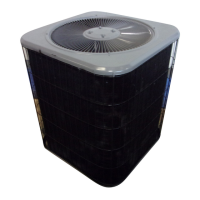Page 9
CAUTION
When using dry nitrogen, a pressure reducing reg-
ulator must be used to prevent excessive pres-
sure in gauge manifold, connecting hoses, and
within the system. Regulator setting must not ex-
ceed 150 psig (1034 kpa). Failure to use a regulator
can cause equipment failure resulting in injury.
C - Evacuating the System
1- Attach gauge manifold. Connect vacuum pump (with vac-
uum gauge) to center port of gauge manifold. With both
manifold service valves open, start pump and evacuate
indoor coil and refrigerant lines.
IMPORTANT
A temperature vacuum gauge, mercury vacuum
(U-tube), or thermocouple gauge should be used.
The usual Bourdon tube gauges are not accurate
enough in the vacuum range.
IMPORTANT
The compressor should never be used to evacu-
ate a refrigeration or air conditioning system.
2- Evacuate the system to 29 inches (737mm) vacuum.
During the early stages of evacuation, it is desirable to
stop the vacuum pumpat least once to determine ifthere
is a rapid loss of vacuum. A rapid loss of vacuum would
indicate a leak in the system and a repeat of the leak
testing section would be necessary.
3- After system has been evacuated to 29 inches
(737mm), close gauge manifold valves to center port,
stop vacuum pump and disconnect from gauge man-
ifold. Attach an upright nitrogen drum to center port of
gauge manifold and open drum valve slightly to purge
line at manifold. Break vacuum in system with nitro-
gen pressure by opening manifold high pressure
valve. Close manifold high pressure valve to center
port.
4- Close nitrogen drum valve and disconnect from
gauge manifold center port. Release nitrogen pres-
sure from system.
5- Connect vacuum pump to gauge manifold center
port. Evacuate system through manifold service
valves until vacuum in system does not rise above
.5mm of mercury absolute pressure or 500 microns
within a 20-minute period after stopping vacuum pump.
6- After evacuation is complete, close manifold center port,
and connect refrigerant drum. Pressurize system
slightly with refrigerant to break vacuum.
D - Charging
Units are factory charged with the amount of HCFC-22 re-
frigerant indicated on the unit nameplate. This charge is
based on a matching indoor coil and outdoor coil with a 20
ft. (6.1 m) line set. For varying lengths of line set, refer to
table 2 for refrigerant charge adjustment. A blank space is
provided on the nameplate to list the actual field charge.
TABLE 2
Liquid Line
Set Diameter
Oz. per 5 ft. (g per 1.5 m) adjust
from 20 ft. (6.1 m) line set*
5/16 in. (8 mm) 2 ounce per 5 ft. (57g per 1.5 m)
3/8 in. (10 mm) 3 ounce per 5 ft. (85g per 1.5 m)
*If line length is greater than 20 ft. (6.1 m), add this amount.
If line length is less than 20 ft. (6.1 m), subtract this amount.
The condensing unit should be charged during warm
weather. However, applications arise in which charging
mustoccurinthecoldermonths.The method of charging is
determined by the unit’s refrigerant metering device and
the outdoor ambient temperature.
Measure the liquid line temperature and the outdoor ambi-
ent temperature as outlined below:
1. -Connect the manifold gauge set to the service valves:
low pressure gauge to suction valve service port; high
pressure gauge to liquid valve service port. Connect
the center manifold hose to an upright cylinder of
HCFC-22. Close manifold gauge set valves.
2. -Set the roomthermostatto call for heat. This willcreate
the necessary load for properly charging the system in
the cooling cycle.
3. -Use a digital thermometer to record the outdoor ambi-
ent temperature.
4. -When the heating demand has been satisfied, switch
the thermostat to cooling mode with a set point of 68_F
(20_C). When pressures have stabilized, use a digital
thermometer to record the liquid line temperature.
5. -The outdoor temperature will determine which charg-
ing method to use. Proceed with the appropriate
charging procedure.

